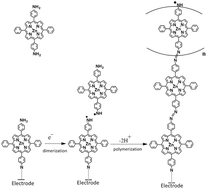Electrochemical fabrication of one-dimensional porphyrinic wires on electrodes†
Abstract
[5,15-Di(4-aminophenyl)-10,20-diphenylporphyrinato]zinc(II) was found to electropolymerize on electrodes such as glassy carbon (GC), indium tin oxide (ITO), and tin oxide, to form a redox-active, stable, and reproducible π-conjugated polymer. Electrochemical and UV/vis spectroscopic studies showed that the electropolymerization involves azobenzene linkage formation via radical intermediates. The electrode modified with the porphyrinic wire featured strong light absorptions in the visible region, thereby serving as a photoanode for a photocurrent generation system.

- This article is part of the themed collection: 2015 Emerging Investigators by ICF

 Please wait while we load your content...
Please wait while we load your content...